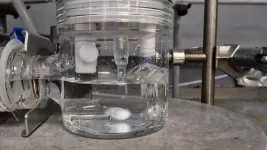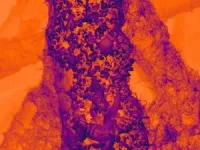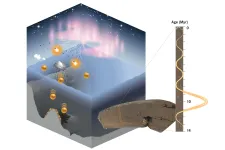(Press-News.org)
Researchers have developed a sustainable catalyst that increases its activity during use while converting carbon dioxide (CO2) into valuable products. This discovery offers a blueprint for designing next-generation electrocatalysts.
A collaborative team from the University of Nottingham's School of Chemistry and the University of Birmingham have developed a catalyst made of tin microparticles supported by a nanotextured carbon structure. The interactions between the tin particles and graphitised carbon nanofibers play a critical role in transferring electrons from the carbon electrode to CO2 molecules - an essential step in converting CO2 into formate under an applied electric potential.
The findings of this research are published in ACS Applied Energy Materials, a journal of the American Chemical Society publishing interdisciplinary research on materials for energy applications.
CO2 is the primary contributor to global warming. While CO2 can be converted into useful products, traditional thermal methods typically rely on hydrogen sourced from fossil fuels. Therefore, it is essential to develop alternative methods like electrocatalysis, which utilises sustainable energy sources, such as photovoltaics and wind power, as well as the abundant availability of water as a hydrogen source.
In electrocatalysis, applying an electric potential to the catalyst drives electrons through the material to react with CO2and water, producing valuable compounds. One such product, formate, is widely used in the chemical synthesis of polymers, pharmaceuticals, adhesives, and more. For optimal efficiency, this process must operate at low potential while maintaining high current density and selectivity, ensuring effective use of electrons to convert CO2 to desired products.
Dr Madasamy Thangamuthu, a research fellow at the University of Nottingham co-led the research team, he said: “A successful electrocatalyst must strongly bond to the CO2 molecule and efficiently inject electrons to break its chemical bonds. We developed a new type of carbon electrode that incorporates graphitised nanofibers with a nanoscale texture, featuring curved surfaces and step edges, to enhance interaction with tin particles.”
Tom Burwell, a research assistant at the University of Nottingham undertook the work whilst studying at Centre for Doctorial Training in Sustainable Chemistry. He developed the approach and carried out the experimental work, he said: “We can assess the performance of the catalyst by measuring the electrical current consumed by the reacting CO2 molecules. Typically, catalysts degrade during use, resulting in decreased activity. Surprisingly, we observed the current flowing through tin on nanotextured carbon increased continuously over 48 hours. Analysis of the reaction products confirmed nearly all electrons were utilised to reduce CO2 to formate, boosting productivity by a factor of 3.6 while maintaining nearly 100% selectivity.”
The researchers linked this self-optimisation to the tin microparticles breaking down into nanoparticles, as small as 3 nm, during the CO2 reduction reaction. Tom Burwell elaborated: “Using electron microscopy, we found that smaller tin particles achieved better contact with the nanotextured carbon of the electrode, improving electron transport and increasing the number of active tin centres nearly tenfold.”
This transformative behaviour differs significantly from previous studies, where structural changes in catalysts are often seen as detrimental. Instead, the carefully engineered support in the catalyst developed by the Nottingham team allows for dynamic adaptation of tin and improved performance.
Professor Andrei Khlobystov, School of Chemistry, University of Nottingham, said: “CO2 is not only a well-known greenhouse gas but also a valuable feedstock for the production of chemicals. Consequently, designing new catalysts from earth-abundant materials like carbon and tin is vital for sustainable CO2 conversion and achieving the UK’s net-zero emissions target. Our catalysts must also remain active over extended use to ensure best value.”
This discovery marks a step change in understanding the design of supports for electrocatalysis. By precisely controlling the interaction between the catalysts and their supports at the nanoscale, the team has laid the groundwork for highly selective and stable catalysts to convert CO2 into valuable products.
This work is funded by the EPSRC Programme Grant ‘Metal atoms on surfaces and interfaces (MASI) for sustainable future’ www.masi.ac.uk which is set to develop catalyst materials for the conversion of three key molecules - carbon dioxide, hydrogen and ammonia – crucially important for economy and environment. MASI catalysts are made in an atom-efficient way to ensure sustainable use of chemical elements without depleting supplies of rare elements and making most of the earth's abundant elements, such as carbon and base metals.
The University of Nottingham is dedicated to championing green and sustainable technologies. The Zero Carbon Clusterhas been recently launched in the East Midlands to accelerate the development and deployment of innovation in green industries and advanced manufacturing.
END
Years before tau tangles show up in brain scans of patients with Alzheimer's disease, a biomarker test developed at the University of Pittsburgh School of Medicine can detect small amounts of the clumping-prone tau protein and its misfolded pathological forms that litter the brain, cerebrospinal fluid and potentially blood, new research published today in Nature Medicine suggests.
The cerebrospinal fluid biomarker test correlates with the severity of cognitive decline, independent of other factors, including brain amyloid deposition, thereby opening doors for early-stage disease diagnosis ...
Beryllium-10, a rare radioactive isotope produced by cosmic rays in the atmosphere, provides valuable insights into the Earth's geological history. A research team from the Helmholtz-Zentrum Dresden-Rossendorf (HZDR), in collaboration with the TUD Dresden University of Technology and the Australian National University (ANU), has discovered an unexpected accumulation of this isotope in samples taken from the Pacific seabed. Such an anomaly may be attributed to shifts in ocean currents or astrophysical events that occurred approximately 10 million years ago. The findings hold the potential to serve as a global time marker, representing a promising ...
A new mathematical model sheds light on how the brain processes different cues, such as sights and sounds, during decision making. The findings from Princeton neuroscientists may one day improve how brain circuits go awry in neurological disorders, such as Alzheimer’s, and could help artificial brains, like Alexa or self-driving car technology, more helpful.
The findings were published February 10 in the journal Nature Neuroscience.
Walking to work, commuters encounter many sensory signals along their route, such as the glow of a crosswalk signal that indicates whether it’s safe to cross or beware of oncoming traffic. ...
Financial markets are reacting not just to Donald Trump's return to the White House but also to the unpredictability of this victory, according to a new study from the University of Surrey. Investors must diversify their portfolios to mitigate risks associated with political volatility and to remain vigilant about the potential for abrupt market corrections.
A new study, published in Economics Letters, indicates that while there was an immediate surge in stock prices following Trump's election, this was quickly tempered by investor concerns over potential trade wars and international instability.
A group of ...
Why do our mental images stay sharp even when we are moving fast? A team of neuroscientists led by Professor Maximilian Jösch at the Institute of Science and Technology Austria (ISTA) has identified a mechanism that corrects visual distortions caused by movement in animals. The study, conducted in mice, identifies a core function that can be generalized across the vertebrate visual system, including primates such as humans. The findings are published in Nature Neuroscience.
Despite its rapid development in recent decades, the video camera industry is still catching up with the capabilities of the human eye. In particular, action cams are designed ...
Euclid blasted off on its six-year mission to explore the dark Universe on 1 July 2023. Before the spacecraft could begin its survey, the team of scientists and engineers on Earth had to make sure everything was working properly. During this early testing phase, in September 2023, Euclid sent some images back to Earth. They were deliberately out of focus, but in one fuzzy image Euclid Archive Scientist Bruno Altieri saw a hint of a very special phenomenon and decided to take a closer look.
“I look at the data from Euclid as it comes in,” explains Bruno. “Even from that first observation, I could see it, but after Euclid made more observations of the area, ...
The report “Assessing Deep-Tech Innovation Hubs in Germany: The Case of Biotechnology” evaluates Germany’s performance in deep-tech innovation within biotech using a comprehensive index and examines five key hubs: Berlin, Heidelberg, Munich, Nuremberg-Erlangen, and Stuttgart. These hubs were analyzed in terms of fundamental research, research and development in biotech, startup activity, public infrastructure, and business environment.
Berlin, Munich, and Heidelberg are the leading biotech hubs
Berlin leads the index due to its strong public infrastructure ...
Experiencing pain may increase the odds that cancer survivors will use cigarettes and cannabis, according to a recent study published by Wiley online in CANCER, a peer-reviewed journal of the American Cancer Society. The study also found that cigarette smoking and pain are linked to more treatment-related side effects and worse health among cancer survivors.
Pain and use of cigarettes, e-cigarettes, alcohol, and cannabis commonly occur together in the general population. To characterize pain in relation to such non-opioid substance ...
Scientists have found that taking a playful approach to life doesn’t mean you don’t take your situation seriously, but it can mean you cope with it better. By surveying people about their experiences during a Covid-19 lockdown, they learned that more playful people were more positive about the future and coped more actively and creatively. Life gave them lemons, and they made lemonade.
“Our study revealed that playfulness and resilience are intimately connected through what we call ‘lemonading’ — the ability to imagine ...
Unresectable canine hepatocellular carcinoma (HCC) has limited nonsurgical treatment options. Sorafenib is a targeted therapy for unresectable canine HCC. However, there are limited reports on the expression of target genes. Therefore, the efficacy of the targeted therapies for canine HCC remains unclear.
In HCC, the prognosis is generally good when complete surgical resection is possible. Unresectable nodular and diffuse HCC have a poor prognosis and limited nonsurgical treatment options. In humans, systemic therapies including ...






